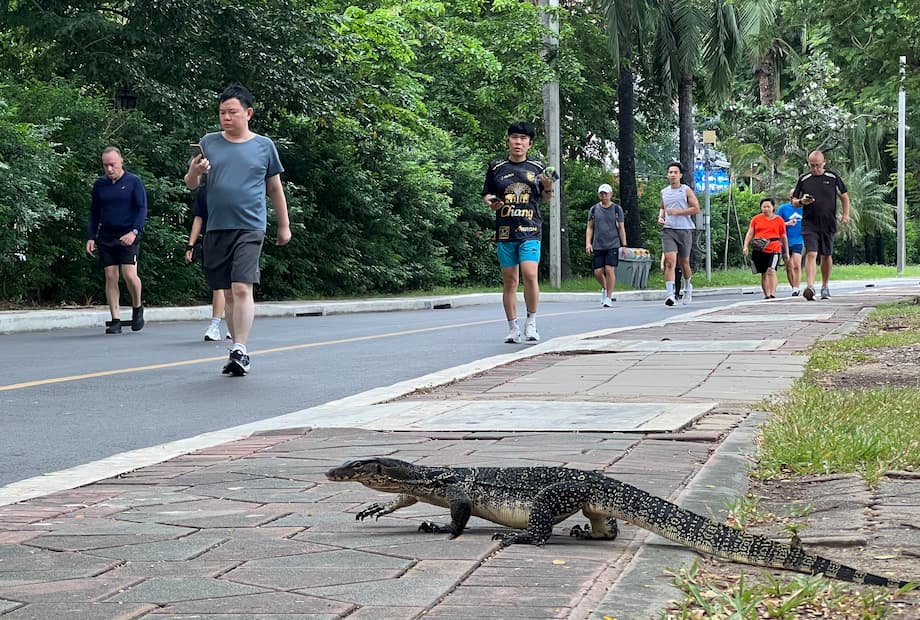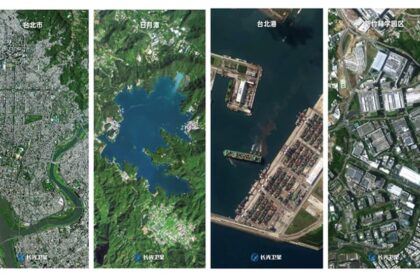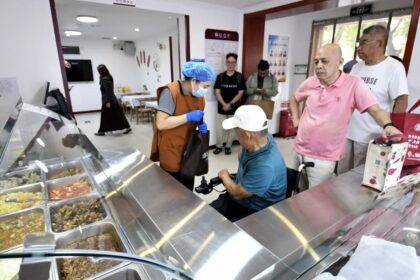Morning workouts meet a new urban wildlife star
Shortly after dawn, Lumpini Park shakes off the night. Runners loop past shaded lakes, tai chi groups glide through their routines, and the outdoor gym clanks to life. Along the water’s edge, another athlete is on the move. Asian water monitor lizards, some the size of a small surfboard, slide into the canals, climb trees to bask, and shuffle across paths in search of a warm patch of concrete. Their presence, once a surprise, now defines the character of Bangkok’s best known green space.
- Morning workouts meet a new urban wildlife star
- How many lizards live in Bangkok’s parks and canals?
- What science says about urban water monitors
- Benefits and risks for residents
- What are authorities doing?
- A new policy frontier: commercial breeding
- Tourism, culture, and the Bangkok Dragon
- How to coexist safely
- The Bottom Line
For many regulars, encounters are part of the routine. One frequent runner described how the smallest lizards can be the trickiest to avoid. The comment captures both the familiarity and the occasional jolt of sharing a park with a large reptile.
A Bangkok resident who runs in the park said: “The big ones are usually fine because they move quite slowly and you can kind of hop over. The small ones can be quite fast. There have been a few times I’ve almost tripped over one.”
How many lizards live in Bangkok’s parks and canals?
The Asian water monitor is the world’s second largest lizard after the Komodo dragon, reaching about two meters in length. It ranges across Southeast Asia and into parts of India and southern China. In Bangkok, the species has found a near perfect urban niche. The capital’s network of more than 1,600 khlongs (canals) connects parks, ponds, and river backwaters, creating a web of wetlands where monitors travel, feed, and hide.
No precise citywide census exists. Lumpini Park remains the best tracked site, with counts typically pegged around 400 individuals and a management target of keeping numbers below that level. In 2016, authorities removed nearly 100 monitors from the park and sent them to a state breeding center to ease crowding, lessen damage to landscaping, and reduce accident risks. Population rebounds have followed removals. Monitors face few urban predators, females can lay around 20 eggs per clutch, and survival rates are high where food is abundant.
Bangkok’s monitors are also woven into local beliefs. The Thai word hia (a common insult) refers to the monitor lizard, yet folklore assigns it both menace and luck. Tawee Somnamee, a caretaker at Lumpini Park, captured that mix of superstition and tourism value when asked why some lizards should remain inside the grounds.
Tawee Somnamee said: “If a hia goes into someone’s room, they will become rich. There should be some left for foreigners to see.”
What science says about urban water monitors
Studies from Bangkok’s parks and wetlands give a clearer picture of how monitors thrive in a megacity. Researchers describe a versatile omnivore that scavenges, hunts opportunistically, and uses canals as sheltered highways. The species appears to be expanding in some urban zones and maintaining genetic diversity despite roads and buildings that fragment habitat.
Diet and cleanup crew
Field work inside Lumpini Park, an urban wetland of about 57.6 hectares, documented what monitors eat and how often they are seen. During survey sessions in rainy and cool months, observers recorded roughly 52 to 55 individual lizards in view at any given point during structured counts, translating to snapshot densities of about 3.9 to 4.7 observed individuals per hectare. That does not equal the full population, since not all animals are visible at once. The same research logged diet items by frequency: eel about 36 percent, arthropod insects 28 percent, carp 20 percent, tilapia 8 percent, turtles 4 percent, and assorted animal remains 4 percent. These numbers underline a vital urban service. By eating fish kills, bird carcasses, and other organic waste, monitors help clear decaying material that can attract pests or spread disease. Their predation on rats and other small animals can dampen vermin pressure around waterways and markets.
Daily activity and city adaptation
Water monitors in Bangkok show flexible daily routines that fit a human dominated landscape. They bask to warm up, then cruise canal edges, lawns, and footpaths where heat reflects off pavement. Tracking in the city indicates many individuals stick close to water and prefer the cover of banks, culverts, and spaces behind buildings during busy hours. Activity rises again when traffic and footfall ease. The species tolerates people at short distances, yet often avoids direct interactions by slipping into the water or under brush. That blend of tolerance and caution helps the lizard occupy parks, zoos, and canal embankments across central districts.
Genetics and movement
Genetic monitoring at Bang Kachao, a large green peninsula in the Chao Phraya River south of central Bangkok, found high genetic diversity for the city’s subspecies, Varanus salvator macromaculatus. Patterns in mitochondrial and nuclear DNA suggest a recent population expansion, likely linked to urban changes that created new aquatic edges and food sources. Evidence of female based dispersal explains why monitors can spread through a patchwork of canals and parks even when males hold small home ranges. For managers, genetics carry practical weight. Captive holding and translocation, which Bangkok already uses to relieve conflict, work best when they preserve local genetic profiles. Comparing the DNA of wild and captive groups before moving animals helps avoid mixing distinct lineages and supports long term monitoring.
Benefits and risks for residents
For people, the Asian water monitor is mostly a neighbor to watch, not fear. It is far less dangerous than the Komodo dragon and does not have a medically significant venom for humans. Bites are rare and usually occur when a person corners or tries to catch an animal. The larger risks in a city are indirect. A startled runner or cyclist might take a spill while swerving. Small dogs and backyard chickens can be vulnerable. Curious individuals sometimes wander into ground floor storage areas, fish ponds, or kitchens near canals, creating moments of panic more than harm.
Public health concerns center on hygiene, not aggression. Like many reptiles, monitors can carry bacteria such as Salmonella. Feeding or touching them increases risk. Coexistence is safest when residents keep a respectful distance, secure trash and pet food, and avoid leaving fish guts or kitchen waste near waterways. Clear sightlines along canal paths reduce surprise encounters, and simple signage on how to act around wildlife can prevent most problems.
What are authorities doing?
The Bangkok Metropolitan Administration has signaled a two track approach: keep numbers in balance at hotspots while educating the public on safe coexistence. Officials say monitors remain protected under the Wild Animal Conservation and Protection Act BE 2562, which prohibits hunting, trading, possession, and harm without permits. City departments have discussed steps with national wildlife authorities, including targeted removals from places where monitors cause repeated conflict and cleaning campaigns along major canals to cut food waste that draws scavengers.
Past interventions show both the promise and limits of removals. In Lumpini Park in 2016, teams used ropes and baited snares to capture dozens of lizards, sending many to a government managed breeding and holding center in Ratchaburi Province. Visitors still see monitors daily, a sign that the park’s habitat can support hundreds and that births soon fill the gaps left by capture. Bangkok officials point to benefits that justify moderation rather than eradication. Monitors help clear carcasses and reduce rats, and data from Thailand’s Zoological Park Organization indicates they are not dangerous to people unless provoked. Public messaging now stresses ways to avoid close contact, give right of way, and call for help if a lizard repeatedly appears inside a home or school.
A new policy frontier: commercial breeding
Thailand has opened a tightly regulated path to commercial breeding of Asian water monitors, citing rising urban numbers and frequent nuisance calls. The Wildlife Conservation and Protection Committee approved limited breeding licenses, with the Department of National Parks, Wildlife and Plant Conservation setting a price of 500 baht per animal for authorized breeding stock. Only animals sourced from state or licensed wildlife stations can enter the program. Every breeder must microchip each monitor and log births and transfers to prevent laundering of wild caught lizards into legal supply chains. Violations of protected wildlife rules can draw prison terms of up to 10 years and fines up to 1 million baht.
Rollout begins at Khao Son Wildlife Breeding Station in Ratchaburi, where hundreds of monitors captured after nuisance complaints are already housed. The ministry has said trading will start once the pricing resolution is published in the Royal Gazette, and early interest from farms and tanneries is high. Water monitors are listed under CITES Appendix II (the Convention on International Trade in Endangered Species), which allows international trade with controls. That framework puts pressure on Thailand to track stock carefully and audit farms. Advocates say regulated breeding can turn a problem into income for rural breeders and reduce illegal imports. Critics worry about incentives that might push poachers to grab wild lizards. Strong microchipping, inventory checks, and transparent inspections will decide whether the policy supports conservation while easing urban conflicts.
Tourism, culture, and the Bangkok Dragon
As Bangkok learns to live with large reptiles, the water monitor has evolved into an unlikely mascot. Viral clips, including one of a monitor climbing the shelves of a convenience store, have changed perceptions. City leaders leaned into that interest by installing an oversized statue at Lumpini Park to celebrate the city’s biodiversity. Local media have taken to calling the species the Bangkok Dragon, a friendly rebrand for an animal long treated as an insult in casual speech.
Visitors now come to parks to spot lizards basking near fountains or gliding through lakes. Guides advise people to keep a few meters of distance, never attempt to feed or touch a monitor, and resist crowding around them for photos. The best viewing tends to be along main lakeshores in late morning when bodies warm in the sun, and later in the day when traffic eases. The draw is real but so is the responsibility. Tourists who respect space, dispose of food waste correctly, and follow posted guidance help keep both people and monitors safe.
How to coexist safely
Practical steps reduce conflict and keep Bangkok’s parks welcoming for everyone.
- Give monitors space. Stop and let them pass rather than trying to step over or around a tail.
- Do not feed wildlife. Food conditioning brings animals closer to paths and homes.
- Secure trash, fish scraps, and pet food. Keep bins closed and off the ground near canals.
- Watch small pets and backyard poultry, especially near water.
- Teach children to look for monitors along paths, and never chase or touch them.
- Cyclists and runners should slow near blind corners by the water.
- Report repeat intrusions into buildings to local authorities so trained teams can respond.
- Support canal cleanups and park rules that keep shorelines clear and sightlines open.
The Bottom Line
- Bangkok’s Lumpini Park supports about 400 Asian water monitors, with citywide numbers unknown across more than 1,600 canals.
- Monitors thrive in urban wetlands, scavenging fish and animal remains and helping control rats, while posing little direct danger to people.
- In 2016, authorities removed nearly 100 monitors from Lumpini, yet numbers rebounded due to high reproduction and survival.
- Research in Bangkok shows flexible daily activity, high genetic diversity, and signs of recent expansion in some urban areas.
- The species is protected under Thai law. Unauthorized possession, trade, or harm can bring severe penalties.
- Thailand has approved licensed commercial breeding with microchipping to prevent illegal capture and to manage demand for hides.
- City officials are combining targeted removals, canal cleanups, and public education to reduce conflict.
- Tourism and social media have turned the monitor into a symbol of urban nature, encouraging respectful wildlife viewing in parks.












